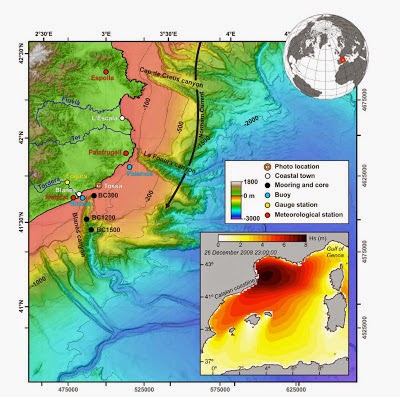Turbidites are sedimentary deposits formed by submarine landslides.
They have a distinctive structure, typically course grained at the base with
the sediment growing finer upwards within the deposit. Since the conditions for
the formation of such deposits tend to persist for long periods of time,
sequences made up of many repeated turbidite deposits are frequently
encountered in the geological record. Such deposits are typically thought to
arise from geologic events such as large Earthquakes or tsunamis.
In a paper published in the journal Geology on 15 August 2014, a
team of scientists led by Charles Paull of the Monterey Bay Aquarium ResearchInstitute describe the results of a study of a sequence of turbidite deposits
on the Eel Fan off the coast of Northern California. The Eel Fan is about 2.6
km beneath the sea surface and lays west the Eel Canyon. The Eel River is
thought to have run directly into the Eel Canyon until the end of the
Pleistocene, when sea levels were lower, but is now separated by about 20 km of
shallow marine shelf.
Map showing location of high-resolution bathymetric
surveys, with respect to Eel Canyon and Eel River, California, USA. Box in
inset shows location of main figure with respect to California. Contours are at
50 m, and every 200 m interval. R.—River. Paull et al. (2014).
Paullet al. surveyed two
areas of scouring, where subsequent landslips have exposed layered deposits,
this the Monterey Bay Aquarium Research Institute’s remotely operated vehicle
(ROV) Doc Ricketts, which was able to both photograph the deposits and drill
cores up to 134 cm in length.
Video still images with an ~2.5 m field of view
showing turbidite beds in scours on Eel Fan, California, USA. Horizontal push core
being taken from the outcrop face is shown in (A). Note beds wrap around
V-shaped ridge in (B). Paull et al.
(2014).
Paul et al. first
attempted to date the deposits using planktic Foraminifera from the fine
grained sections of the sequences, but were unable to find sufficient material
to do this. Next they attempted to obtain dates from reworked benthic
Foraminifera (i.e. Formainiferans buried once then excavated and reburied by
geological events) in the courser grained parts of the deposits. This resulted
in dates of between 29 100 and 6100 before the present. Finally they obtained
carbon isotope dates from wood samples within the deposits, producing dates of
between 12 800 and 7100 years before the present.
By calculating the thinkness and age of the individual beds combined
with their approximate ages, Paull et al.
conclude that the turbidite flows occurred at a rate of about one every 36
years in the later part of the sequence, but about once every seven years
during the Early Holocene (about 12 900 to 8000 years ago). This is far more
frequent that can be accounted for by major Earthquake events, but fits well
with the known frequency of flood events on the Eel River, which in the Early
Holocene would have entered the sea much closer to the Eel Canyon.
See also…
Foraminiferans are Amoeba-like single-celled organisms found either
free-floating or attached to surfaces in marine ecosystems. Many build ornate
tests (shells) from calcium carbonate, and planktonic forms...
Unlike most Sponges (Porifera), which feed by filter feeding water
pumped through their bodies, Carnivorous Sponges (Cladorhizidae) feed by
capturing Crustaceans and other small animals on hooked spicules on
filaments, then digesting them externally. The group are predominantly
found in deep water, where carnivory is presumed to be a better feeding
strategy than filter...
Turbidites are sedimentary rock formations formed by submarine
landslides. They are very distinctive, as water is very efficient at
separating sediments by particle size, since larger, heavier particles
will sink rapidly but smaller, lighter particles will remain in
suspension for longer, taking more time to settle out. The upshot of
this is that turbidite deposits show a...
Follow Sciency Thoughts on Facebook.





